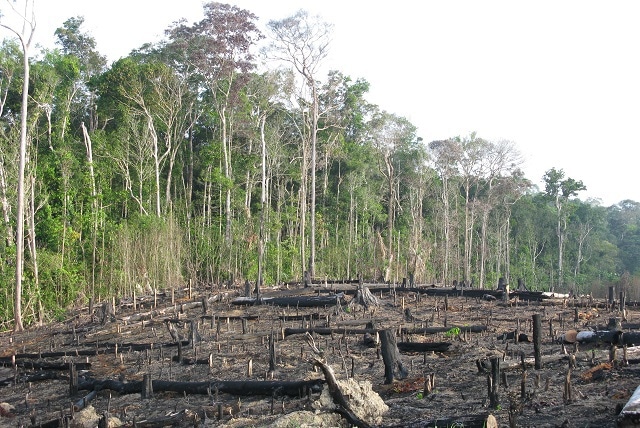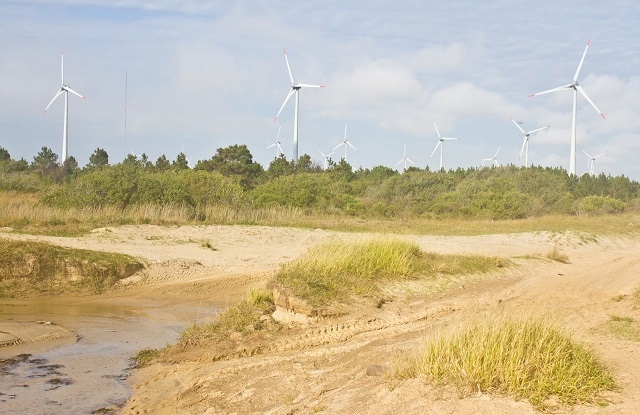Brazil is also home to the Amazon River Basin, which is the largest rain forest on Earth. Hot and humid both day and night, the Amazon River Basin is home to thousands of known plant and animal species, as well as countless species that have yet to be discovered. Despite this ecological and animal diversity, the Amazon rain forest is also a major carbon sink, meaning it sequesters vast amounts of global carbon dioxide.
Environmental Issues of Brazil
Brazil’s rainforest areas, which are the country’s crown jewel, has also unfortunately experience extensive deforestation of these regions over the last several decades as a result of the expanding agricultural industry of this country. Soy and cocoa are two of Brazil’s biggest cash crops, therefore the proliferation of farmlands to accommodate the demands of these products has wiped out large swaths of rain forest. According to the World Wildlife Fund (WWF), 90% the Atlantic Forest ecosystem in southern Brazil has been wiped out due to the cocoa boom of the 1970s.

20 January 2010: A destroyed section of the tropical rainforest, Amazonia, Brazil. Image Credits: guentermanaus/shutterstock.com
Despite the global awareness surrounding the importance of limiting deforestation in this country, data recently acquired from Imazon, Brazil’s forest monitoring group, released that the Amazon’s forest lost as of June 2018 skyrocketed to 1,169 square kilometers. To put this number into perspective, this area is 343 times the size of New York’s Central Park and has increased by 108% since September 20072. Various political factors have been found to contribute to this rise in deforestation, such as the election of Michel Temer in Brazil, who has cut funding for environmental monitoring and enforcement. In addition to the increase in agricultural demands by foreign countries, particularly the U.S., the ongoing dry conditions of the Amazon increase the risk of forest fires in this area that subsequently results in land degradation and deforestation.
In addition to deforestation, illegal poaching has further enhanced the strain on many of Brazil’s native species. The country currently has hundreds of its species that are classified as endangered, some of which include the jaguar, sea turtle, and ring-tail monkey. To address this issue, Brazil officials issued 18 fines in September of 2017 that totaled to what is equivalent to $2.3 million USD for the poaching of endangered Amazon river turtles and their eggs4.
Waste disposal, particularly in urban centers, is another major environmental problem in Brazil that has caused major protests to arise in 2013. During this time, a study conducted by a Brazilian sanitation trade organization found that Rio de Janeiro generates half a billion tons of garbage each year, which is equivalent to the same amount of waste produced in Shanghai, China; a city that is also facing a waste disposal crisis. A recent order by Brazil’s Supreme Court in July of 2018 that prohibited the construction of landfills in protected areas, since approximately 80% of Brazil’s current landfills are located in environmentally protected areas5. The decision is expected to not only apply to future businesses, but also current ones that will be forced to stop their operations and restructure their waste disposal procedures.
Environmental Policies of Brazil
In the 1990s, Brazil was cutting down large tracts of trees which amounted to the equivalent Brazilian rainforest quantity that can cover Belgium each year, according to The Economist. However, public sentiment has shifted significantly since then towards an increased amount of conservation.
Brazil has come under significant criticism for its Forest Code, which was passed in 2012. The law gave amnesty to landowners who illegally cleared lands before 2008 and reduced the area to be reforested from 500,000 to 210,000 square kilometers. Many people called that reduction a big win for Brazilian agriculture and a big defeat for conservationists.
Climate Change: Lessons from Brazil's Forest Policy. Video Credits: Yale University/YouTube
The Forest Code also introduced two measures that were popular with conservationists. First, it created a market for landowners to trade surplus forests that might be legally deforested on one property to offset restoration of forests on a different property. In addition, a 2014 study revealed that this market could also reduce the areas that required restoration to as small as 5,500 square kilometers of arable land.
The second aspect of the Forest Code set up an online land registry system that simplifies the process for landowners to register their property boundaries and ecological data. More advanced tracking and documentation of more than 5 million rural properties will significantly enhance enforcement, the study found. In a recent amendment to the Forest Code, Brazilian conservationists approved a requirement illegally deforested areas of the Amazon will have to be reforested by the alleged perpetrators of this illegal activity; however, much controversy surrounds this decision that rejected claims that the initial deforestation cause unconstitutional effects to the environment7. Despite this controversy, the ruling did recognize some of the consequences that result from Brazil’s massive deforestation and its connection to climate change, a loss of biodiversity in these areas, water supply and overall quality of life of Brazilians living in surrounding areas.
Clean Technology in Brazil
According to recent reports, Brazil is currently a mixed bag when it comes to investments in clean technology; however, some promising signs of an emerging clean technology industry are apparent. For example, Brazil has acquired more than $10 billion in wind power investments since 2009. Additionally, government incentives have encouraged producers of wind energy industries to partner with local suppliers. The Brazilian government has also been a big proponent of international green building standards, which has pushed many local governments in this country to promote the legislation of clean technology, such as that which involves providing land charge discounts for water recycling, waste reduction or renewable energy use.

Wind power plant, Tramandai, Rio Grande do Sul, Brazil. Image Credit: Lisandro Luis Trarbach/shutterstock.com
Current wind capacity in Brazil, which is the largest in Latin America, is approximately 9 gigawatts (GW); which is only expected to continue to grow as increased financial support for this technology is maintained. As a result of this impressive installed capacity, wind energy is currently sold in conventional energy auctions alongside hydropower and fossil fuels. By 2024, Brazil has set a goal of 24 GW of wind generation capacity to be installed around the country13.
A Clean Future for Brazil?
A clean future for Brazil will largely depend on the ability of the government to manage and properly shape its clean technology policies. The country is said to have a labyrinth of regulations that are hostile to innovation and foreign investment; however, visionary companies and the perseverance of the public appear to make this future of Brazil a promising reality.
This article was updated 27th July 2018.
Follow Brett on Twitter for more of his work - @ParkstBrett
References
- Brazil Facts - National Geographic
- “Deforestation skyrockets in the Amazon rainforest” – Mongabay News
- Brazil Environmental Issues - Brazil.org.za
- “Brazil Issues $2.3 Million in Fines for Poaching Amazon Turtles” – Bloomberg BNA
- Environmental Problems in Brazil - The World Wildlife Fund for Nature
- “Supreme Court Decision Threatens Sustainable Waste Management Across Brazil” – Folha De S. Paulo
- “Analysis: the Brazilian Supreme Court’s New Forest Code Ruling” – Mongabay
- Brazil's Garbage Becomes an Olympic Challenge - Huffington Post
- How Brazil Became the World Leader in Reducing Environmental Degradation - The Economist
- Untangling Brazil's Controversial New Forest Code - ScienceDaily®
- 5 Things You Didn't Know About Green Business in Brazil - GreenBiz
- Unleashing Brazil's Innovation Potential - Accenture
- “Brazil – Renewable Energy” – Export.gov
This article was updated on the 24th July, 2018.
Disclaimer: The views expressed here are those of the author expressed in their private capacity and do not necessarily represent the views of AZoM.com Limited T/A AZoNetwork the owner and operator of this website. This disclaimer forms part of the Terms and conditions of use of this website.